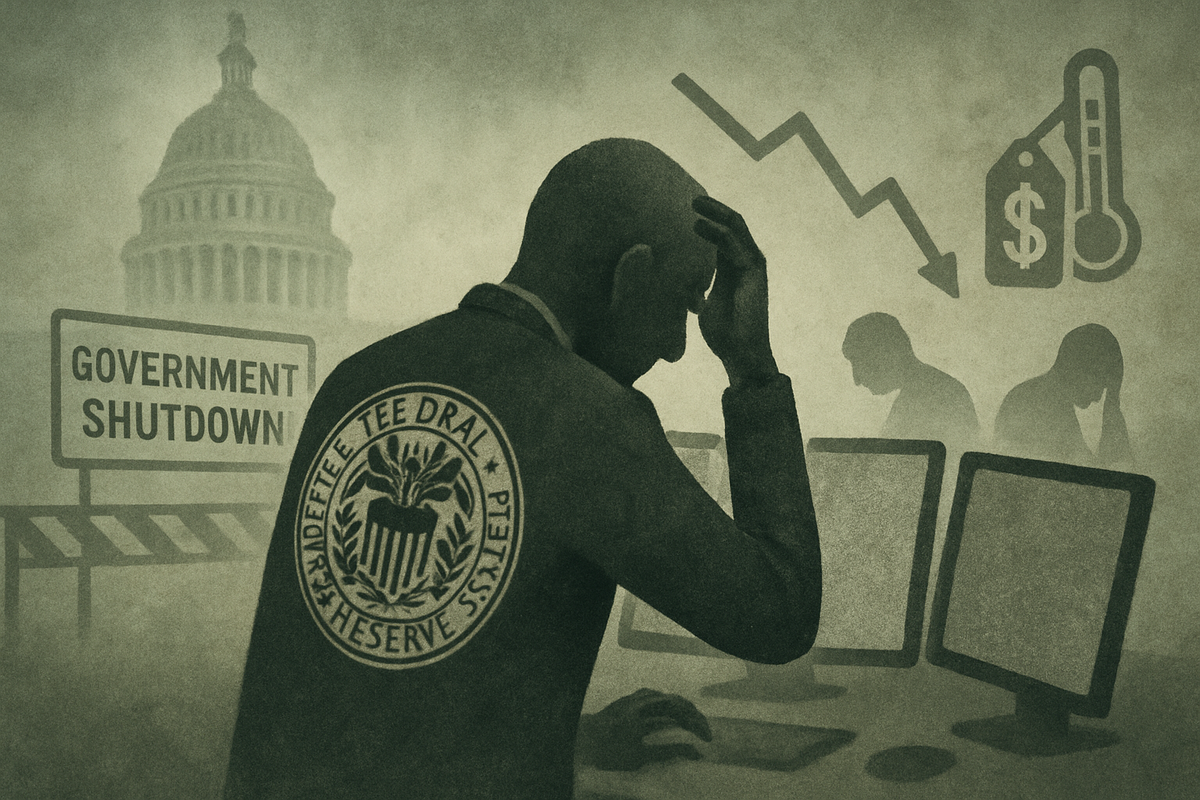
A looming or active government shutdown presents a formidable challenge to the Federal Reserve's critical mission of fostering maximum employment and price stability. As federal agencies responsible for vital economic data collection grind to a halt, the Fed finds itself operating in a fog, deprived of the timely and accurate information essential for informed monetary policy decisions. This data vacuum complicates the central bank's efforts to navigate a weakening labor market and persistent inflationary pressures, raising concerns about the precision and effectiveness of its future actions.
The immediate consequence of a shutdown is a severe impairment of the Fed's economic monitoring capabilities. Key indicators from the Bureau of Labor Statistics (BLS) and the Bureau of Economic Analysis (BEA), including the crucial monthly jobs report, Consumer Price Index (CPI), and Personal Consumption Expenditures (PCE) price index, are delayed or suspended. This data deprivation leaves the Federal Reserve with an incomplete and potentially misleading picture of the economy's health, making it exceedingly difficult to assess the true state of the labor market and the trajectory of inflation.
Federal Reserve Navigates a Data Desert
The specter of a government shutdown, whether ongoing or recently resolved, casts a long shadow over the Federal Reserve's ability to execute its dual mandate. Historically, government shutdowns have crippled the flow of essential economic statistics, leaving policymakers to grapple with significant uncertainty. During such periods, agencies like the Bureau of Labor Statistics (BLS) and the Bureau of Economic Analysis (BEA) cease or severely curtail operations, leading to the indefinite postponement of critical data releases. This includes the monthly jobs report, which offers a granular view of employment trends, and key inflation gauges such as the Consumer Price Index (CPI) and the Personal Consumption Expenditures (PCE) price index.
The timeline leading up to such a moment typically involves intense political wrangling in Congress over appropriations bills. When lawmakers fail to agree on funding legislation by the deadline, non-essential government services are halted, and federal employees are furloughed. Key players in this high-stakes drama include the U.S. Congress, the White House, and the Federal Reserve itself. While the Fed operates independently, it relies heavily on data generated by other federal entities. Initial market reactions to the prospect or reality of a shutdown are often characterized by increased volatility and a flight to safety, as investors brace for economic uncertainty and potential policy missteps. Without reliable data, the Fed is forced to rely on less comprehensive private-sector reports, anecdotal evidence, and potentially outdated official figures, significantly clouding its economic outlook and complicating its deliberations on interest rate adjustments.
During past shutdowns, the absence of timely data has forced the Fed to either delay significant policy shifts or make decisions based on incomplete information. For instance, a prolonged data blackout could make it challenging for the Fed to determine if a weakening labor market necessitates a pivot towards more accommodative monetary policy, or if inflation remains sticky enough to warrant continued restraint. This reliance on less robust information can lead to a more cautious, potentially reactive approach, rather than the proactive, data-driven strategy the Fed prefers. The disruption in data collection also risks compromising the accuracy of future reports, as gaps in raw data collection cannot always be easily filled once operations resume. This further exacerbates the challenge, creating a lag effect on the quality of economic intelligence available to policymakers.
Companies Brace for Impact: Winners and Losers in a Data-Scarce Economy
A government shutdown, compounded by the Federal Reserve's impaired ability to respond effectively, creates a volatile environment where certain public companies may find themselves on either side of the economic ledger. The uncertainty stemming from a lack of reliable economic data and potential monetary policy missteps can ripple through various sectors, altering investment landscapes and operational strategies.
Companies heavily reliant on government contracts, such as defense contractors like Lockheed Martin (NYSE: LMT) or IT service providers to federal agencies like Booz Allen Hamilton (NYSE: BAH), are often immediate losers. A shutdown can lead to payment delays, project suspensions, and a general slowdown in government spending, directly impacting their revenue streams and cash flow. Similarly, industries sensitive to consumer confidence and discretionary spending, such as retail (e.g., Walmart (NYSE: WMT), Target (NYSE: TGT)) and hospitality, may suffer if federal workers are furloughed, leading to a drop in consumer demand. Financial institutions like JPMorgan Chase (NYSE: JPM) or Bank of America (NYSE: BAC) could face increased market volatility, reduced lending activity due to economic uncertainty, and potential impacts on interest rate expectations, which directly influence their profitability.
Conversely, some sectors or companies might experience relative stability or even benefit from the flight to safety. Companies in defensive sectors, such as utilities (e.g., NextEra Energy (NYSE: NEE)) or consumer staples (e.g., Procter & Gamble (NYSE: PG)), tend to be more resilient during economic downturns or periods of uncertainty, as demand for their products and services remains relatively stable. Gold mining companies or those involved in precious metals could see an uptick as investors seek traditional safe-haven assets. Furthermore, companies that provide essential services not directly tied to federal funding, or those with strong international revenue streams, might be less affected. However, the overarching theme for most businesses is increased unpredictability. The Fed's struggle to accurately gauge economic health means companies lack clear signals on future interest rate paths or the true strength of consumer demand, making capital allocation, hiring, and expansion decisions significantly more challenging.
Wider Significance: A Collision of Fiscal and Monetary Policy
The current predicament, where a government shutdown hobbles the Federal Reserve, highlights a critical intersection of fiscal and monetary policy and the inherent risks of political gridlock. This event fits into a broader trend of increasing political polarization impacting economic governance. When Congress fails to pass appropriations, it doesn't just halt government services; it effectively ties the hands of the central bank, preventing it from performing its crucial role as the economy's stabilizer. This creates a dangerous feedback loop: political dysfunction leads to economic uncertainty, which then impairs the Fed's ability to mitigate that uncertainty, potentially exacerbating economic downturns or prolonging inflationary pressures.
The ripple effects extend beyond direct government contractors. Competitors and partners across various industries face an uneven playing field. Companies with greater financial resilience might weather the storm better, potentially gaining market share from weaker rivals. Regulatory implications are also significant; a shutdown can delay new regulations, suspend enforcement, and slow down critical approvals, creating both opportunities and challenges depending on the industry. For example, a delay in environmental permits could benefit some industries in the short term, while delaying essential infrastructure projects for others. Historically, government shutdowns have often coincided with periods of heightened market anxiety, though the long-term economic impact has varied depending on the duration and severity of the shutdown. Comparisons to previous shutdowns, such as those in 2013 or 2018-2019, show similar patterns of delayed data and increased market volatility. However, the current context of persistent inflation and a potentially weakening labor market adds an extra layer of complexity, making the Fed's data blind spot even more perilous. This situation underscores the delicate balance required between legislative action and independent monetary policy, and how a breakdown in one can severely undermine the efficacy of the other.
What Comes Next: Navigating the Fog of Uncertainty
Looking ahead, the immediate aftermath of a government shutdown, particularly one that impairs the Federal Reserve's data collection, presents a landscape filled with both short-term challenges and long-term strategic considerations. In the short term, markets will likely remain volatile as investors react to the lack of official economic data and speculate on the Fed's next moves. The central bank itself will need to adapt, potentially relying more heavily on alternative data sources, anecdotal evidence from its regional banks, and qualitative assessments to inform its policy decisions. This could lead to a more cautious, "wait-and-see" approach to interest rate adjustments, even if underlying economic conditions warrant a more decisive action.
Over the longer term, companies may need to re-evaluate their reliance on government stability and data transparency. Strategic pivots could include diversifying revenue streams away from government contracts, building larger cash reserves to weather periods of economic uncertainty, and investing in advanced analytics to gather their own market intelligence. Market opportunities may emerge for companies that can provide superior private-sector economic data or analytics services to businesses and even to the Fed itself, filling the void left by government agencies. However, the overarching challenge remains the increased difficulty in forecasting economic trends and making informed investment decisions. Potential scenarios range from a quick resolution and a rapid return to data normalcy, allowing the Fed to regain its footing, to a prolonged shutdown that could significantly dampen economic growth and force the Fed into reactive policy measures, potentially leading to an overcorrection in either direction regarding inflation or unemployment. Investors should prepare for continued uncertainty and a potentially more opaque economic outlook in the coming months.
Wrap-Up: The Enduring Impact of a Blinded Fed
The government shutdown's entanglement with the Federal Reserve's operational capacity represents a significant disruption to the finely tuned machinery of economic governance. The key takeaway is the critical importance of timely and accurate economic data for effective monetary policy. Without it, the Fed is effectively flying blind, making its dual mandate of achieving maximum employment and stable prices far more challenging, especially in the current environment of a weakening labor market and persistent inflation. This event underscores how political impasses can have direct and profound economic consequences, extending beyond immediate government services to the very core of the nation's financial stability.
Moving forward, the market will likely exhibit heightened sensitivity to any news regarding the shutdown's resolution and the subsequent resumption of data releases. Investors should closely monitor the Fed's communications for any shifts in its assessment of the economy, particularly how it plans to navigate the data vacuum. The lasting impact could be a renewed appreciation for the often-unseen but vital role of government statistical agencies and the independent function of the central bank. What investors should watch for in the coming months includes the speed at which economic data flows normalize, any revisions to previous economic figures once data collection resumes, and the Fed's rhetoric regarding its confidence in the economic outlook. The ability of the Fed to regain a clear picture of the economy will be paramount in determining the path of interest rates and the overall health of the market in the foreseeable future.
This content is intended for informational purposes only and is not financial advice






